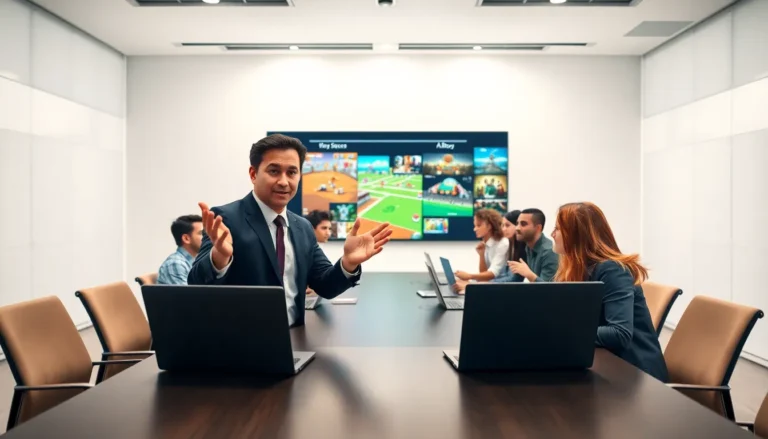In a world where traditional job structures are rapidly evolving, freelance creativity has emerged as a powerful force. Many individuals are tapping into their artistic talents and skills, crafting unique careers that offer both flexibility and fulfillment. This shift not only allows freelancers to express their creativity but also empowers them to shape their own professional paths.
Freelance creativity encompasses a wide range of fields, from graphic design and writing to photography and digital marketing. As the gig economy grows, so do the opportunities for creative minds to connect with diverse clients and projects. Embracing this lifestyle isn’t just about working independently; it’s about harnessing one’s passion and turning it into a sustainable livelihood.
Table of Contents
ToggleOverview of Freelance Creativity
Freelance creativity encompasses a range of artistic endeavors that allow individuals to express their skills while pursuing flexible career paths. The gig economy facilitates this shift, offering numerous opportunities for professionals in diverse fields.
Key areas within freelance creativity include:
- Graphic Design: Freelancers design visuals for branding, advertising, and digital platforms. They use tools like Adobe Creative Suite to produce compelling artwork.
- Writing: Freelance writers create content for blogs, websites, and publications. Specialties include copywriting, technical writing, and creative writing.
- Photography: Freelance photographers capture images for various purposes, from weddings to commercial projects. They often market their services through social media.
- Digital Marketing: Freelancers in digital marketing help businesses increase their online presence. They utilize SEO, social media strategies, and data analytics to drive engagement.
Freelance creatives adapt to client needs and market trends, allowing them to thrive in a dynamic landscape. They showcase their work through portfolios, leveraging platforms like Behance and LinkedIn to connect with potential clients.
Benefits of Freelance Creativity

Freelance creativity presents numerous advantages, enabling individuals to thrive in flexible environments while pursuing their artistic passions. Below are key benefits associated with freelance creative careers.
Flexibility and Freedom
Flexibility in scheduling allows freelancers to work at times that align with their peak productivity. Freedom in choosing projects promotes personal satisfaction and alignment with individual interests. Freelancers can also adjust their workload to balance personal commitments and professional responsibilities. By working remotely, they reduce commuting time and costs, thereby increasing overall efficiency.
Diverse Opportunities
Freelance creatives engage in a variety of projects across multiple sectors. Opportunities span industries such as advertising, entertainment, education, and technology. They can collaborate with businesses of all sizes, from startups to established corporations. Freelancers often discover niche markets for specialized services, enriching their portfolios and skill sets. The gig economy provides platforms for connecting with global clients, increasing exposure and potential for higher earnings.
Challenges of Freelance Creativity
Freelance creativity presents unique challenges that can impact personal and professional growth. Two significant obstacles include isolation and financial instability.
Isolation and Loneliness
Isolation and loneliness often stem from the solitary nature of freelance work. Freelancers typically operate without a consistent team or workplace interactions, diminishing opportunities for networking and social engagement. This disconnection can lead to feelings of isolation, which may affect creativity and motivation. Many freelancers combat this challenge by joining co-working spaces or participating in online communities, allowing them to connect with peers and share experiences. Engaging with supportive networks helps maintain a sense of belonging and diminishes the emotional toll of working independently.
Financial Instability
Financial instability poses a persistent challenge for freelance creatives. Income can fluctuate due to project availability and client demands, leading to unpredictable earnings. Many freelancers face difficulties in budgeting, as irregular income streams complicate financial planning. Additionally, securing clients and negotiating contracts can add stress to the financial landscape. To mitigate these risks, freelancers can diversify their income sources, establish a savings buffer, and utilize financial management tools, ensuring they maintain consistent cash flow and stability during lean periods.
Techniques to Enhance Freelance Creativity
Freelancers can boost their creativity through effective techniques that optimize their time and working environment. Implementing structured strategies fosters innovation and enhances productivity.
Time Management Strategies
- Prioritize tasks: Determine the most critical assignments each day using tools like the Eisenhower Matrix. This helps freelancers focus on urgent and important work first.
- Set deadlines: Establish self-imposed deadlines to create a sense of urgency, increasing motivation. Tools like Google Calendar can help remind of upcoming due dates.
- Utilize techniques: Apply methods like the Pomodoro Technique, which divides work into 25-minute intervals followed by short breaks. This can maintain focus and replenish creative energy.
- Schedule breaks: Plan regular breaks to recharge. Engaging in physical activities or stepping outside can stimulate fresh ideas and counteract burnout.
- Review progress: Evaluate performance weekly to understand what works and what doesn’t. This reflection allows freelancers to adjust strategies for better outcomes.
Building a Creative Workspace
- Choose the right location: Select a workspace that inspires creativity. Whether it’s a home office, co-working space, or a café, the environment should foster concentration and innovation.
- Declutter the space: Maintain an organized workspace by removing unnecessary items. A clean environment reduces distractions and promotes clarity of thought.
- Incorporate personal elements: Add frames with artwork, motivational quotes, or personal achievements to the workspace. These elements can spark joy and provide inspiration.
- Optimize furniture: Invest in ergonomic furniture that promotes comfort and productivity. A well-designed chair and desk setup can reduce fatigue and enhance focus.
- Utilize technology: Equip the workspace with essential tools like high-speed internet, quality software, and digital devices to streamline tasks and facilitate creativity.
By applying these techniques, freelancers effectively harness their creativity, leading to improved work quality and satisfaction.
Case Studies of Successful Freelancers
Graphic Designer: Emma Johnson
Emma Johnson, a graphic designer specializing in branding, achieved success by leveraging social media. By showcasing her design process and finished projects on Instagram, she attracted clients from various industries. Emma utilized online platforms like 99designs to secure projects and establish her portfolio. Her technique of engaging with followers led to referrals, significantly increasing her client base and income.
Writer: David Lee
David Lee, a freelance writer, built a niche in technology content. He created a blog focused on tech reviews and industry analysis, which enhanced his visibility. By networking on LinkedIn and contributing to well-known publications, David established credibility. His approach of pitching tailored article ideas to potential clients led to ongoing collaborations, providing both financial stability and creative fulfillment.
Photographer: Sarah Kim
Sarah Kim, a freelance photographer, specializes in event photography. Her strategic use of a portfolio website and SEO optimization attracted local clients seeking wedding and corporate event photography. Sarah emphasizes client relationships, ensuring personalized service that encourages repeat business. By offering package deals and referral discounts, she expanded her clientele rapidly, showcasing the importance of customer engagement in freelance success.
Digital Marketer: Jonathan Smith
Jonathan Smith, a digital marketer, identifies key trends in online marketing. He harnesses data analytics to drive effective campaigns for small businesses. By attending industry conferences and workshops, Jonathan stays informed about the latest marketing tools and strategies, allowing him to adapt to market changes swiftly. His detailed reporting and measurable results attract long-term contracts, underscoring the value of continued education in freelancing.
Combined Success: Freelancers’ Collaboration
A group of freelance creatives collaborated on a cross-disciplinary project involving graphic design, writing, photography, and digital marketing. By pooling their resources and talents, they launched a successful online platform promoting sustainable lifestyle products. This collaboration demonstrated how freelancers can partner to expand their reach and leverage diverse skills to create successful projects that individual efforts might not achieve alone.
Freelance creativity offers a unique blend of flexibility and opportunity for those looking to turn their passions into profitable careers. By navigating the gig economy, freelancers can explore diverse projects and engage with various clients, enhancing their skills and portfolios. While challenges like isolation and financial instability exist, they can be managed with strategic planning and community support.
Ultimately, the freelance landscape empowers individuals to create meaningful work that resonates with their interests. Through effective time management and workspace optimization, freelancers can unlock their full creative potential and build sustainable careers that reflect their artistic vision.


